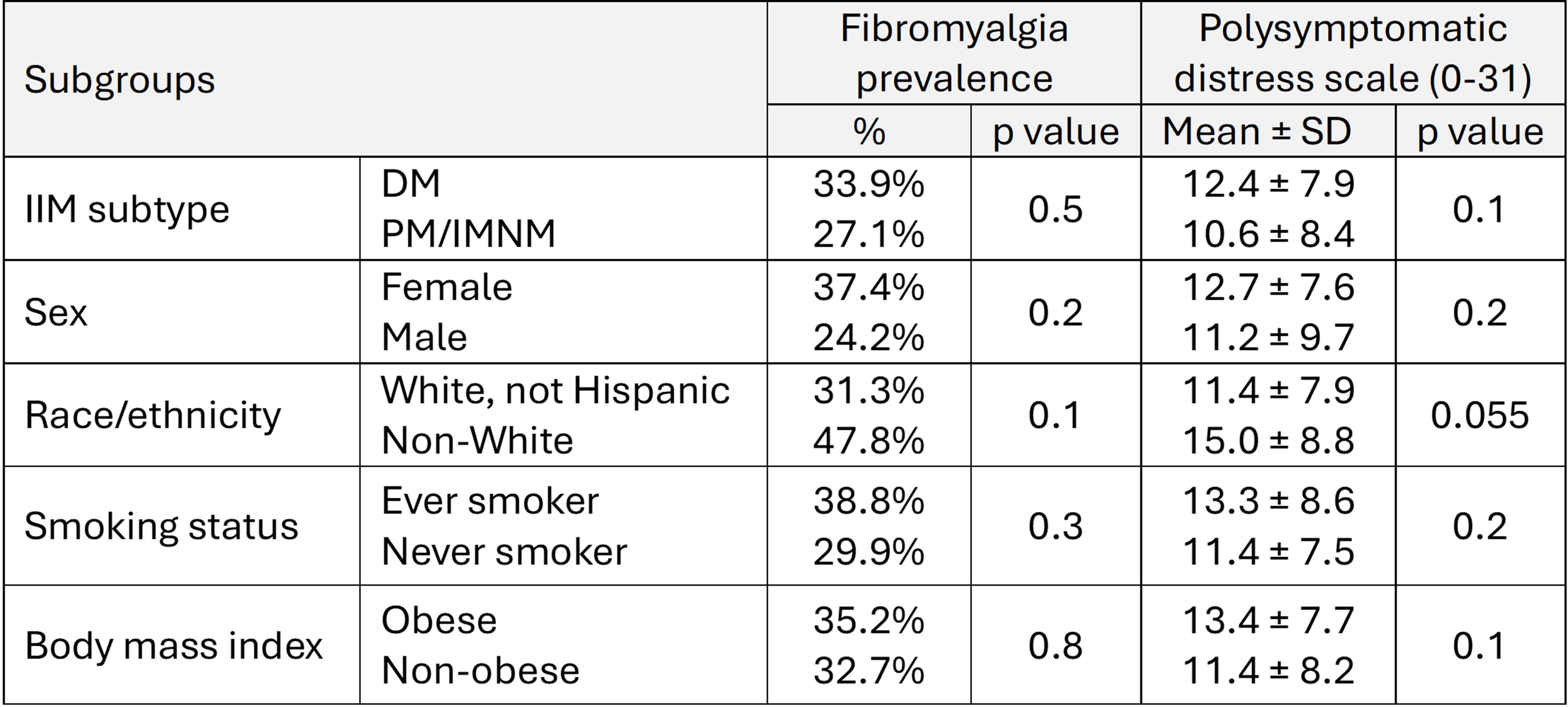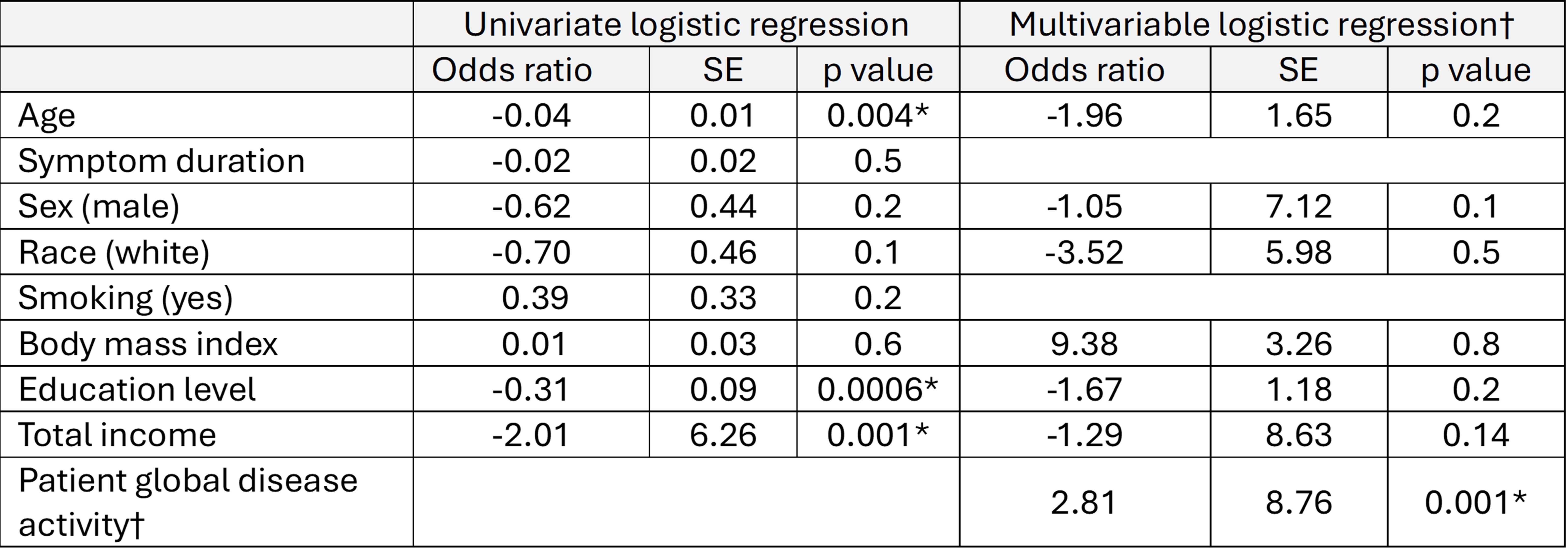Session Information
Date: Sunday, November 17, 2024
Title: Muscle Biology, Myositis & Myopathies – Basic & Clinical Science Poster II
Session Type: Poster Session B
Session Time: 10:30AM-12:30PM
Background/Purpose: Fibromyalgia (FM) is the prototypical central pain disorder that can be associated with rheumatic conditions such as rheumatoid arthritis, Sjogren’s disease and lupus. Patients with comorbid FM may have worse scores on patient reported outcome measures despite similar objective measures of disease activity which may affect assessment of treatment response. Therefore, information on the burden of comorbid FM in rheumatic diseases is essential. Prevalence of FM in patients with idiopathic inflammatory myopathies (IIM) has not been previously studied. In this study, we examined the prevalence and impact of FM as well as the level of “fibromyalgianess” in patients with IIM using The National Databank for Rheumatic Diseases, a US-wide longitudinal registry.
Methods: FORWARD is a longitudinal prospective registry of adults with rheumatic diseases in the US who are primarily recruited from rheumatology clinics. Participants included in this study had physician diagnosis of IIM and completed comprehensive semiannual questionnaires on their health status including pain, fatigue, physical function, disease activity, sociodemographic features, and health services. We examined the prevalence of FM, level of “fibromyalgianess” (assessed with polysymptomatic distress score) in subgroups and compared the characteristics of patients who fulfilled the 2016 modified FM criteria and those who did not. Logistic regression models were conducted to examine the univariate association of baseline sociodemographic factors with FM diagnosis. All the significant variables were then included in a logistic regression model to examine the association between fulfilling FM criteria and patient global disease activity after adjusting for baseline factors.
Results: A total of 210 patients with IIM (age 55.3 ± 14.0, 78% women) were included in the study. Approximately 34% of patients with IIM fulfilled the modified FM criteria. FM prevalence and polysymptomatic distress scale score were similar across subgroups of disease subtype, sex, race, smoking status, and obesity (Table 1). Those with concomitant FM were significantly younger, had worse fatigue, patient global disease activity, disability, quality of life, and comorbidity index, were more likely to have depression, anxiety, diabetes mellitus and pulmonary disorder, lower education level and total income, and were more likely to be prescribed opioids (Table 2). These patients also had significantly lower health satisfaction and a higher number of emergency room visits. FM diagnosis was significantly associated with younger age, lower education level and total income on regression models (Table 3). Odds of having FM increased by 2.8 times with each point increase in patient global disease activity after controlling for age, sex, race, body mass index, education level and total income.
Conclusion: One third of patients with IIM have comorbid FM, which is similar to patients with rheumatoid arthritis and lupus. Comorbid FM is associated with worse disease activity and clinical outcomes, poorer sociodemographic factors and higher health care utilization in patients with IIM. Recognition and management of comorbid FM may improve outcomes in patients with IIM.
*p<0.005
Abbreviations: VAS: Visual analog scale, HAQ: Health Assessment Questionnaire, NSAIDs: Nonsteroidal anti-inflammatory drugs.
†The model included fibromyalgia criteria as dependent variable, patient global disease activity as independent variable, and other variables as confounders.
Abbreviations: SE: Standard error
To cite this abstract in AMA style:
Saygin D, Schmukler J, Wipfler K, McKennan C, Duan J, Michaud K, Lee Y. Prevalence and Impact of Fibromyalgia in Patients with Idiopathic Inflammatory Myopathies [abstract]. Arthritis Rheumatol. 2024; 76 (suppl 9). https://acrabstracts.org/abstract/prevalence-and-impact-of-fibromyalgia-in-patients-with-idiopathic-inflammatory-myopathies/. Accessed .« Back to ACR Convergence 2024
ACR Meeting Abstracts - https://acrabstracts.org/abstract/prevalence-and-impact-of-fibromyalgia-in-patients-with-idiopathic-inflammatory-myopathies/



